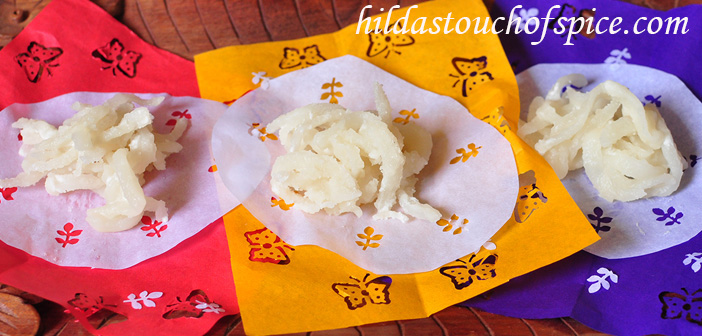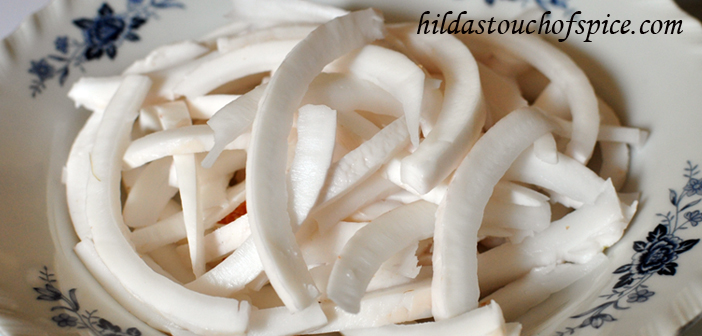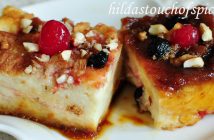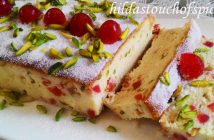 Teias de Aranhas is popularly known as “Gons” (bunches or clusters) while some refer to it as “Cobwebs”. This tender coconut candy is traditionally prepared and set on circular butter paper or colored kite paper doilies. It is prepared in the hot summer months when the weather is dry and there is less humidity in the air.
Teias de Aranhas is popularly known as “Gons” (bunches or clusters) while some refer to it as “Cobwebs”. This tender coconut candy is traditionally prepared and set on circular butter paper or colored kite paper doilies. It is prepared in the hot summer months when the weather is dry and there is less humidity in the air.
To beat the summer heat, the consumption of tender coconut water is at its peak and the tender coconut flesh is in plentiful. At all times, you may not want to eat the flesh of tender coconuts so it is put to good use by preparing candy which can be eaten over a short duration.
Traditionally, the color of Teias de Aranhas (Gons) is white to retain the natural purity and flavor of the delicate tender coconut. To make it more festive and interesting you can make it colorful if you so like.
Well, this juicy coconut candy with a light and delicate crunch reminds me of my maternal Grand Uncle’s home in Anjuna, Goa. Every summer vacation would be a treat in his huge mansion surrounded with innumerable coconut palms and choicest fruit orchards. He had an abundance of everything. His wife would be eternally supervising the cooks and all the other helpers / attendants. The dining table was super large! I was fortunate to witness and taste many of the goodies that were prepared and laid on that gorgeous, gigantic table! Lo and behold! The very elegantly laid Teias de Aranhason circular butter paper and displayed on colorful kite paper did catch my curious eye. It would be served after meals as a part of the many desserts.
While on vacation in Goa, we would be busy sipping the cool, sweet coconut water all the time to quench our thirst instead of water so there was a lot of tender coconut which would be often converted into “Gons.”
This Goan Tender Coconut Candy is one of my hubby’s favorites. He always refers to it as “Gons” and never the long name “Teias de Aranhas”. I don’t think anyone refers by that name! Every time we visit Goa, my hubby does the rounds of the bakeries and the markets to purchase “Gons” but unfortunately it is off the shelves. Just once did we get it at ‘Dalima Bakery ‘in Margao while we were on our way to ColvaBeach.
Oh! Where have all the gorgeous, dainty and traditional sweets of Goa disappeared?? Will our future generations ever know the sweet delicious taste of Goan delicacies? But there is hope that the future generations will continue with preserving our culture, heritage and our most loved Goan Cuisine. Thanks to many who share wholeheartedly on the internet!! 🙂
Yes, “Gons” is a little time consuming to make and does not have a long shelf life so it is better to consume it quickly while it is fresh. If well covered in an airtight box it can remain well for a few days in your fridge.
To prepare “Gons”,you need the tender coconut to be firm. It is a little tricky to select the pieces of tender coconut …not too tender…and yet not too firm. The tender coconut has to be sliced into thin ribbons. The candy has to set just right! Lightly crisp and firm. Every piece should have the crunch but must crumble with every bite. You must feel the juicy goodness and the tenderness of the coconut.
Above all the weather must be kind to the best gift of nature…the COCONUT!! 🙂 So here is the recipe for the ultimate pristine white and delicate Goan Tender Coconut delicacy…Teias de Aranhas (Gons) … pretty little bunches arranged on cute little paper doilies just for you and for all future generations to relish and be proud of! 🙂
Make them at Christmas, at celebratory occasions and festivals… pack them up in your gift hamper or simply savor the goodness and flavor of tender coconut in a candy when you feel like it! 🙂
Ingredients:
- 2 Tender Coconuts with firm flesh
- 2 cups sugar
- 1/2 cup Water
- 1 tsp Milk
- 1 tsp. Rose Water – optional
- Butter paper/colored or white kite paper doilies or cut into squares or circles of about 5 inches.
- Scoop out the coconut flesh or ask the coconut seller to do it for you. Then scrape off the brown skin, if any. The coconut should be pristine white.
- Cut the firm tender coconut flesh with a sharp knife into reasonably thick and long strips like ribbons and soak in normal water.
- In a sufficiently wide, deep and thick bottomed pan place the sugar with water and bring to a boil. Stir to dissolve the sugar.
- Add milk to clarify the syrup. Skim off the impurities that rise to the top.
- When the syrup is warm strain it through a fine sieve.
- Boil the syrup again to a two string consistency. Then add the rose water; if using.
- Strain the coconut strips through a sieve to drain off the water completely.
- Add the coconut strips to the syrup and cook till the mixture is thick. Keep stirring and make sure the sugar does not caramelize.
- Switch off the heat and let the mixture rest until it is warm. You should be able to drop the mixture on the butter paper.
- Place the butter paper or kite paper doilies on trays.
- Arrange sugar coated coconut strips in the center of each paper doily in a circular pattern or drop them in small clusters/bunches on each paper cut out or doilies.
- Keep the prepared trays of Teias de Aranhas (Gons) in a dry place to harden.
- This may take a few hours or overnight to harden depending on the climatic conditions.
- Serve fresh or store in the fridge in an airtight box.
- Enjoy your Gons / Teias de Aranhas… the ultimate Goan Tender Coconut delicacy.
Tips & Suggestions:
- You can make them look pretty and interesting by adding a tinge of your favorite edible color or make them more attractive with different food coloring.You may also use essences accordingly.
- Teias de Aranhas (Gons) does not have a long shelf life. It is always better to enjoy it when it is fresh and crisp.
- It is better to set the “Gons” on butter or parchment paper and serve the hardened pieces on colorful kite paper. Remember if using colored kite paper, it will bleed when in contact with the syrup.




